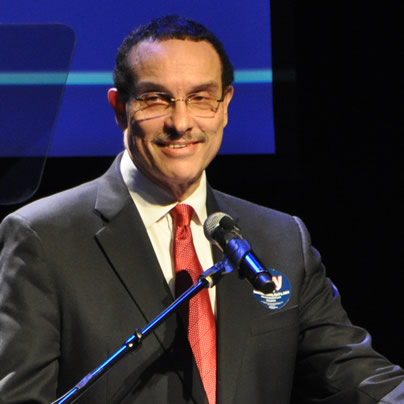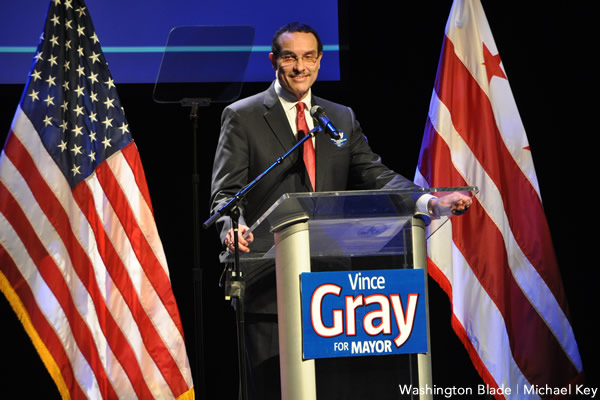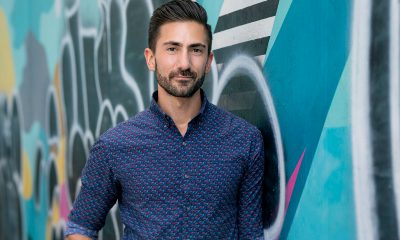Opinions
Why I support Vincent Gray for mayor
‘It is not in his DNA to lie or cheat’


D.C. Mayor Vincent Gray is running for re-election. (Washington Blade photo by Michael Key)
On April 1, 2014, I will cast my ballot for Vincent C. Gray for mayor. It was an easy decision for me but may not be for many other voters. The open investigation surrounding his 2010 campaign is entering into many people’s decision. I am convinced that the majority will come to the same conclusion and believe the mayor when he says he has done nothing illegal. I choose to accept his apology. One look at his life, not just the politician, and you must conclude it is not in his DNA to lie or cheat. Gray’s life has been spent working for those who couldn’t fight for themselves and he dedicated himself to the non-profit field eschewing the money track. Many in government, including current Council members, have made millions being paid for their influence in office. Gray’s time in politics and government, only 13 years out of a long career, was full time and didn’t include looking for sources of outside income.
By every measurable indicator his administration has been successful. So for those who will consider voting against the mayor based on supposition and innuendo, which is all there is regarding his personal role in his 2010 campaign, it would be my hope they take a second look before casting their ballot. They might just reconsider voting for him in the primary and ensuing election based on the health of the city. The District is moving in the right direction in every area including public safety; education reform; and fiscal stability. Moreover his administration is doing everything possible to improve the lives of the residents of every ward.
The continued success of a city means giving credit to those who came before. Mayor Gray, along with starting new initiatives in the areas of employment and economic development; upping the level of service delivery; education reform and strengthening the safety net; has built on the positive initiatives begun under former Mayor Anthony Williams. That progress continued under former Mayor Adrian Fenty, elected overwhelmingly in 2006. He continued the reforms that Williams began and added his signature accomplishment, wresting control of the education system and placing it in the mayor’s office. He did that with the help of then Council Chair Vincent Gray. His chosen chancellor, Michelle Rhee, made great strides in reforming the system but after three years was under fire for how she worked, or didn’t work, with the community and her desire for personal publicity. While the Fenty administration made continued improvements in delivering city services it also spent down the city’s reserve fund by $600 million leaving the District at serious risk for lower bond ratings.
Gray became mayor at the time the nation was coming out of a recession and had the opportunity to make great strides in a fairly short time. He used all those opportunities. He continued education reform with Kaya Henderson as chancellor, and in 2013, based on national tests, the children of the District improved more than children in any other urban district. Gray authored and introduced the bill for universal pre-K education when he was Council Chair and that has resulted in some of the great strides our children are making.
Gray inherited an underfunded reserve and worked to rebuild the District’s fiscal solvency. He has been wildly successful while at the same time improving the delivery of city services. Because Gray rebuilt that reserve to $1.6 billion he was able to keep the D.C. government open during the federal shutdown. Then working with Del. Eleanor Holmes Norton, he ensured that the District is now exempt from federal shutdowns through 2015. Gray is the first mayor to not only stand up to the federal government but along with some members of the Council and brave citizens sit down for their beliefs. He led an act of civil disobedience and again showed what he is made of as a person. Another indication of the man is that Gray has been the most supportive elected official the LGBT community has ever had. He has lost friends because of his principled stands but never hesitated to speak openly about his support for the community.
The Gray administration has been very successful in attracting new business to the District. During the first three years of the Gray administration the District has earned high marks from those who rate cities and their achievements. In 2013, Forbes magazine rated the District the #1 New Tech Hot Spot; Politicom rated us the #1 strongest economy in the United States; and the American College of Sports Medicine rated us the #2 fittest city in the nation. The mayor created the Mayor’s Council on Physical Fitness, Health and Nutrition and pushed fitness in the schools and continues to build new bike lanes. In 2012, we were rated #1 for LEED-certified Projects by the U.S. Green Building Council and the mayor initiated the strongest plan for turning a city green in the nation.
The mayor revamped the city’s Department of Employment Services to ensure that city residents would be able to receive training for the jobs that would become available and his One City-One Hire program, which has now accounted for more than 9,000 new jobs for city residents, won a Harvard University Bright Idea Award in 2012. In all, since the Gray administration began the city has scored as one of the top 10 cities in the nation, often #1, on 17 best of lists from best educated, best for college grads, venture capital investment, retail investment and hippest city.
Because of the efforts of the Gray administration, the District continues to thrive and attracts more than 1,000 new residents a month, many of them young or empty nesters who contribute to the tax base. In addition all you have to do is walk through some of the city’s rebuilt neighborhoods where once there were few children to see the baby carriages and the parks being used and a new vibrancy that comes from more families making the city their home.
But D.C. is still a tale of two cities. There are great economic disparities and Mayor Gray has worked to ensure that while we rebuild our neighborhoods with a focus on housing, nightlife and restaurants, we don’t forget those who have not yet benefitted from the improving economy. Some are disingenuous and talk about the mayor only going with the flow and continuing already started projects. But a fair assessment shows how wrong this is. In 2006, Mayor Fenty held a groundbreaking for the O Street Market, which Council Chair Gray attended. It was only later that he found out there was no financing for the project. Upon taking office as mayor, he worked with Roadside, the developer, to get the financing for that project. His administration worked to get the financing on track for CityCenter as well. It was the Gray administration that finalized the financing and signed the agreement that brought $900 million from Qatar into the District of Columbia. It was the Gray administration that after 20 years of nothing happening got the Skyland project in Ward 7 on track and they are ready to start construction.
Mayor Gray fought to bring Walmart into the District over the concerns of some who felt it would harm local small business. The fact is that in areas of the District where Walmart is going there were few small businesses to harm. These were neighborhoods that had no groceries at all and where people had to go by car or public transportation if they wanted to shop for their families. At the same time the Gray administration is addressing the issue of food deserts, which we have in the District. Addressing one of the most pressing issues in the District, Mayor Gray has allocated $187 million to jump-start the building of 10,000 affordable housing units, which no previous administration has done. It is the Gray administration that has worked to get the commitment from Microsoft for a research center in Ward 8.
There are other projects and concerns that have languished under other administrations for years with only talk and which Mayor Gray has addressed successfully. For years the city has been under court order to address the issue of transportation for the District’s children with disabilities. Today that court order has been lifted because of the work of the Gray administration. He worked successfully to lift the Dixon decree, which was the mental health case that had been in place for 35 years. Mayor Gray committed in his first State of the District speech that he would stop sending our special-needs children to private schools and develop appropriate programs for them in our public schools. The year before he came into office the District spent $168 million sending special-needs children to private schools. By building the capacity in the District’s schools to give those children a good education here the cost of private placements has now been reduced to less than $80 million.
Mayor Gray’s 2010 platform of ONE CITY was recognition that every community has basic interests that are the same including safe streets, a quality education, decent housing, a place to shop and a place to recreate. But the ONE CITY vision also recognized that we are a great place to live because of our cultural diversity and that respect for everyone no matter where they come from, what their sexual orientation or gender identity, is paramount. Each person should be entitled to celebrate their heritage, culture and life, and share it with others. His vision included being the most openly supportive elected official the LGBT community has ever had. He never hesitates to speak out forcefully for the civil and human rights of all people. From his time on the Council where his efforts enabled marriage-equality legislation to pass and he worked to fight hate crimes, to his current employment and training programs for the transgender community, he has been there and accounted for every step of the way.
As mentioned earlier, Gray has spent only 13 of his working years in government and politics. It is a great misconception that he is a lifelong politician. Gray spent a career in the non-profit field eschewing many opportunities to earn the big bucks that so many are after. His disciplined approach to public service was born from humble beginnings. He grew up in a one-bedroom apartment at 6th and L streets, N.E. Although his parents never attended high school, they instilled in their son a solid work ethic and deeply rooted values. Mayor Gray attended Logan Elementary and Langley Junior High Schools, and graduated at the age of 16 from Dunbar High School, where he excelled in academics and sports. He then went on to George Washington University. While at George Washington, he became the first African American admitted to the GW fraternity system, and in his junior and senior years, became the first person to serve consecutive terms as chancellor of Tau Epsilon Phi. Upon graduation he was scouted by Major League Baseball teams but instead chose to dedicate his life to his community. His dedication to children and their families has been the hallmark of his service in both city government and the non-profit sector.
Gray began his professional career with The Arc of D.C. (then known as the Association of Retarded Citizens) where he successfully advocated for innovative policy initiatives on behalf of people with developmental disabilities, and spearheaded the closure of the District-run Forest Haven mental institution after it was exposed for poor conditions and abuse of patients.
Gray’s foray into local government was in 1991 when Mayor Sharon Pratt Kelly appointed him to the post of director of the Department of Human Services where he oversaw the functions of a 7,000-person department and directed activities related to Public Health, Social Services, Mental Health Services and Health Care Finance. In this role, he spearheaded the implementation of several initiatives to address the developmental needs of children and oversaw the first citywide HIV/AIDS project. While knowing that success in that position was always going to be questioned Gray believed that ensuring the safety net for those in need was a priority and had to become a priority for the District government.
He left government in 1994 and instead of looking to cash in on his time in government as so many others have he took the position as the first executive director of Covenant House Washington, an international, faith-based organization dedicated to serving homeless and at-risk youth. During his decade at the helm of Covenant House, Gray helped make the organization one of the most effective of its kind in the District, and led successful campaigns to purchase and renovate a crisis center for homeless youth and a multi-purpose center and built a new community service center in the far southeast community of D.C.
Then in 2004, he was convinced by his neighbors to run and he won election as the Council member from Ward 7. During his first two years on the Council he chaired a special committee on the prevention of youth violence, and continued his fight against the AIDS crisis by creating the Effi Barry HIV/AIDS initiative. After only two years he was convinced to run and won his citywide election for chair of the Council. Running on the theme of “One City,” he continued his lifelong focus on uniting the disparate racial and economic groups in his hometown.
As chairman, Gray was a leader in efforts to improve the Council’s operations, transparency and oversight capacity, and was a true champion for school reform. He spearheaded the Pre-K Expansion and Enhancement Act, which established a voluntary, high-quality pre-school program to provide 2,000 new classroom slots for three-and four-year-olds over six years. The mayor’s diligence resulted in that goal being met in September of 2010, well before the 2014 target. During his time as chair, the Council was rated one of the most respected legislatures in the nation.
What people should remember in judging Vincent Gray is that he didn’t ever anticipate being mayor. When he was sworn in as Council Chair on Jan. 1, 2007, Fenty was being sworn in as mayor and had just had an overwhelming victory winning every precinct in the District. It was clear to many as it was to Gray that Fenty could be mayor for life if he chose that route. It was only after Fenty squandered that good will and the polls showed him losing to Gray that Gray even got into the mayor’s race. Fenty had a bankroll of $5 million at the time Gray began his campaign. Even counting the ‘shadow campaign’ Fenty had $1.5 million more than Gray to spend on his campaign and the power of the incumbency to go along with that.
Gray has rightfully apologized for his 2010 campaign, and he agreed that as the candidate he had to apologize even if he personally didn’t do anything wrong. After living in the District all his life and having lifetime friends who worked on his campaign he found that some of them did illegal things in a very misguided effort to help him. They were wrong but legally and otherwise we should not be held personally accountable for the mistakes of our friends. We should apologize and he has done that. We should abide by the legal system that everyone must abide by and he has done that. In the three years of the investigation no one has accused him of a crime.
We are three years into the Gray administration and there is no question, even from many of those who keep challenging him with regard to the 2010 campaign, that the city continues to move forward and he has had many successes. There are challengers who suggest that the city is under a cloud because of the mayor and that has held us back. But not one of them can point to an area where we have been held back. Most of the challengers sit on the City Council and can’t point to one piece of legislation that they wanted to introduce that they couldn’t because of the investigation into the 2010 campaign. In fact the mayor and his appointed attorney general introduced a very strict campaign finance reform bill and the Council has thus far refused to pass it.
None of the mayor’s challengers has the administrative background to indicate they could administer the city government. At most they have run small office staffs and in one case run a small chain of restaurants, which is very different from administering a city with a budget of more than $10 billion. The question voters must ask themselves is if they believe the city is headed in the right direction, then why would they take a chance on changing administrations?
Slogans are easy to campaign on but the work of running a city is very different.

The felon in the White House, who has lied his way to victory, has now signed his ‘big disgusting bill’ into law. He has managed to get members of Congress to agree to screw their own constituents, and vote for this abomination of a bill.
Republican members of Congress who have said it will be a disaster in their states. Who have said it will force the closure of rural hospitals, and throw seniors out of nursing homes, in their states, because they will lose their Medicaid. Who have said they oppose the bill because it will add $3.3 trillion to the deficit, which young people will suffer for in years to come. They have said they oppose it because it pretends to help those earning tips and overtime, but close reading of the fine print shows it does practically nothing for them. But because their lips are firmly attached to Trump’s ass, they voted for it anyway. It is the biggest transfer of wealth from the poor to the rich in the country’s history. Now if that doesn’t give decent people the incentive they need to fight, to take back their country, nothing will. And when I say fight, I mean with their votes.
To win, Democrats need to stop the self-immolation. Democrats are doing fine across the nation. Winning many special elections for state legislatures and the judiciary. Even when they don’t win, the margins in solid Republican districts are way down. Democrats will win governorships in New Jersey and Virginia this year. So instead of Democrats constantly talking about how bad the polls are for the party, and trashing each other, they need to focus on what it will take to win back Congress in 2026. The best way to start is to trash Republicans. I am concerned about groups like David Hogg’s PAC, and figures like Sen. Bernie Sanders, supporting candidates against sitting Democrats. Spending money and time on primaries against sitting democrats, even old ones, may not be the way to go this cycle. We need one focus — taking back Congress in 2026. That means laser like focus on which seats are winnable; open seats, and Republican seats, in both the House and Senate. Doing this is the only way we can stop the felon in the White House, and his MAGA sycophants in Congress, from doing more damage in his final two years as president. Time to face reality, that is really all that can be done for now.
If Democrats take back the House, they can stop the budget machinations Trump is trying to get done. If Democrats take the Senate, they can stop the felon from getting any more MAGA judges, or disgusting unqualified executive branch nominees, confirmed. Again, that has to be the singular focus for 2026 for anyone serious about stopping Trump. I, too, want younger members of Congress. I would urge older Democrats, those in safe districts, to voluntarily step aside. But spending millions to primary them, when in most cases history shows they will win anyway, seems counterproductive at this time. Choose the best candidates in primaries for open and Republican seats — those with the best chance of winning in the general election. I have given my support at this time to Zach Wahls, running to unseat Sen. Joni Ernst in Iowa.
Democrats must remember that most of the voters in the nation are moderate and concerned with kitchen table issues. So, while there are districts far left candidates can win, like Mamdani who just won the mayoral primary in New York City, we have seen such candidates lose in most of the country. There are takeaways from Mamdani’s win in New York for every candidate, other than everyone likes things for free. I recommend candidates look at the brilliant way he used social media. That is something Democrats around the country need to learn. People, especially young people, get their news that way these days. Then Democrats must accept the midterm elections are really local elections. They will be about what the local Democratic candidate campaigns on, and the contrast to what the Republican Party is doing for, or in most cases to, the voters in that particular district.
If Democrats do anything nationally it should be to flood the airwaves with the negatives of Trump’s bill. If done right Democrats will win. Then stop trashing Democrats who don’t agree with you on every issue. Again, stop listening to the likes of Bernie Sanders, who tells people if they don’t like everything about a Democrat, they can vote for an independent. History tells us that only helps Republicans.
Understand the most important vote any legislator makes is their first one. It determines who will control the legislature. Who will be Speaker of the House, and Majority Leader in the Senate, and most state legislatures. If the vote is for the Democratic leadership, then Democrats control the agenda, and committees. That is how to make a real difference.
Stop listening to those who claim the Democratic Party is not clear on what it stands for. The Democratic platform has been clear for years. Democrats support equality, unions, working people, Social Security, Medicare, and Medicaid. They support the right of women to control their bodies; support equality for the LGBTQ community. Democrats are for a fair immigration policy; doing everything possible to fight climate change, and protect the environment; bringing down prices for groceries, gas, and rent. If Democrats take back control of committees, in both state legislatures, and Congress, they can once again begin to move forward on all those issues.
So, stop the self-immolation, and attack Republicans. They are the enemy of the people, not a Democrat who you may not agree with on every issue. Try to move forward as a united Democratic Party. If everyone understands and does that, Democrats will win in 2025 and 2026, and will stop the felon in the White House before he totally destroys our country.
Peter Rosenstein is a longtime LGBTQ rights and Democratic Party activist.
Opinions
USAID’s demise: America’s global betrayal of trust with LGBTQ people
Trump-Vance administration dismantled agency after taking office

The U.S. Agency for International Development — proudly my institutional home for several years of my international development career and an American institutional global fixture since November 1961 — is no more.
How will USAID’s closure impact LGBTQI+ people around the world, especially in poor, struggling countries (“the Global South”)? Time will tell, but “dire,” “appalling,” and “shameful” are appropriate adjectives, given the massive increase in HIV/AIDS deaths that follow the callous, abrupt, and unspeakably cruel cut-off of funding for USAID’s health and humanitarian programming in HIV/AIDS prevention, treatment, and care.
Regarding LGBTQI+ people and issues, USAID worked in a tough neighborhood. In Africa alone, more than 30 countries in which USAID had programming still criminalize same-sex relationships, often to the point of imposing the death penalty. These fiercely anti-LGBTQI+ countries share harsh anti-LGBTQI+ punishments with most countries in the Middle East and North Africa. Other countries where USAID formerly worked retain colonial-era sodomy laws.
Where did USAID fit into all this turbulence? The agency was not allowed to transgress local laws, so how could it support the human rights of local LGBTQI+ people? USAID did so by building close and trusting relationships with local LGBTQI+ civil society, and by “superpower advocacy” for the universal human rights of all people, including those of us in the queer community.
I served at USAID’s Africa Bureau under the Obama administration, becoming the only openly transgender political appointee in USAID’s history. In that role, I was privileged to have a platform that caught the astounded attention of both queer people and of anti-LGBTQI+ governments around the world. If the president of the United States can elevate a transgender woman to such a senior position within the U.S. government, that open declaration of acceptance, inclusion, worth, and recognition set a precedent that many in the LGBTQI+ community worldwide hoped their countries would emulate.
Serving as an openly queer person at USAID also afforded me the opportunity to meet with many fiercely anti-LGBTQI+ senior politicians and government officials from African countries who sought USAID funding. Uganda’s first woman speaker of the parliament, Rebecca Alitwala Kadaga and her whole delegation came to see me at USAID in Washington about such funding. I had some very frank (and USAID-approved) “talking points” to share with her and her team about President Obama’s strong and secular commitment to equal human rights for all people. My tense meeting with her was also an opportunity to educate her as to the nature of the transgender, nonbinary, and intersex community — we who are simply classified and discriminated against as “gay” people in Uganda and in most countries in the Global South. I also had the chance to represent USAID in the “inter-agency” LGBTQI+ human rights task team led by openly gay U.S. Ambassador David Pressman, whose effective leadership of that Obama-era initiative was inspirational.
Working closely with professional, capable, and caring USAID career employees such as Ajit Joshi and Anthony Cotton, and with the strong and open support of the USAID Deputy Administrator Don Steinberg, I helped to craft and promote USAID’s very first LGBTQI+ policy. Under President Obama, USAID also created the LGBT Global Development Partnership, a public-private partnership supporting LGBTQI+ civil society groups throughout the Global South. USAID funding also increased for programs promoting LGBTQI+ inclusion, anti-violence, and relevant human rights protections. This programming expanded further (albeit never adequately funded) during the Biden administration under the able leadership of USAID Senior LGBTQI+ Coordinator Jay Gilliam and his team.
So what did it all mean? Has USAID left a footprint for the global LGBTQI+ community? Will its absence matter?
In my view, that answer is an emphatic yes. International development and humanitarian response go to the heart of recognizing, respecting, and caring about universal human dignity. USAID converted those ethical commitments into tangible and meaningful action, again and again, and modelled for the world what it means to truly include all persons.
My time serving at USAID was a high point of my career, being surrounded by the best of American civil servants and foreign service officers. For me, “USAID Forever” remains my battle cry. Let’s start thinking of how we will rebuild it, beginning in three years.
Chloe Schwenke is a professor at Georgetown University’s McCourt School of Public Policy.
Opinions
Community comes together to repair WorldPride history exhibition
Vandals damaged pictures, timeline walls on June 22

Earlier this month, vandals shouting homophobic slurs damaged the 8-foot hero cubes and timeline walls of the Rainbow History Project’s (RHP) WorldPride exhibition “Pickets, Protests, and Parades: The History of Gay Pride in Washington.” The week’s incident was the fifth homophobic attack on the exhibition chronicling DC’s LGBTQ+ History, the vandalism damage was only made worse by the storms this past week.
In response, RHP posted a call online for volunteers and donations and over a dozen volunteers showed up on Saturday to repair the exhibition in its final stretch.
It took three hours, but the group assembled during a heat advisory to bend the fences back into place, fix the cubes and zip tie all the materials together to keep them safe. Some of those who came out to volunteer, Slatt said, were known RHP volunteers but most were total strangers who had attended an event here or there or just wanted to get involved for the first time, one was even in D.C. as an out-of-town guest and after seeing the Instagram call, decided to spend their day lifting some heavy fencing back into place.
When asked why they showed up, volunteer Abbey said: “especially during Pride month, it’s so important to come together as a community, not just to celebrate, but to support each other. To know that this historic exhibit is even able to exist right now under this administration is really amazing. The fact that we’re just able to help continue it in its last leg of being out here is really important.”
“Rainbow History Project does a lot of work for the community,” another volunteer Ellie said, “they show up in a lot of ways that I think we really need right now, so in terms of being asked to come out and do a couple hours of lifting, that is something that we can easily support and do.”
“We put out a call asking for support from the community, and so we didn’t know what we’d get,” Slatt continued, “but strangers have shown up. We were upset, we were crying. We were trying to come up with a battle plan and more and more people have shown up with open arms and empty hands to do this. It’s 95 degrees, we are melting in the heat. It’s just amazing the number of people who have come here.”
If anything, the anonymous exhibit designer said, the people who vandalized the exhibit made the community stronger and mobilized members passionate about preserving and sharing our histories. Their efforts backfired in a big way — bringing together people who had only attended one or two RHP events or had read about the organization online to actively contribute to the work.
It’s a meaningful representation of the history of D.C.’s LGBTQ+ community, one that often starts with a small group of people who come together to protest but soon mobilize their communities and enact monumental change in the nation’s capital.
“If Pride in D.C. started with 10 people picketing the White House,” Slatt remarked, “you just got 12 more to join the gay history movement.”
This was especially poignant, another volunteer Mattie said, on the week that the Supreme Court issued a decision allowing Tennessee to ban puberty blockers and hormone therapy for minors seeking gender affirming care. It was a devastating moment for the LGBTQ+ community who mobilized once more in front of the Supreme Court this past Friday.
“It’s been actually really important to see this community come together in the face of direct attack on our history in the wake of direct attacks on our rights,” Mattie said, “and we stand up to that. We come together, and we represent. That is so important to maintaining our strength and our community throughout trying times now and ahead.”
When asked about how community members can support RHP’s work and repair the damage long-term to the exhibit, Slatt urged people to donate to RHP, to volunteer as exhibit monitors, and to come visit the exhibit.
“We’ve been doing this for 25 years. This is our 25th anniversary, and if it weren’t for volunteers donating their time and their talents, if it weren’t for small dollar donors, we would never have gotten anything done,” Slatt said. “I’d say to anyone out there that we are on this plaza all through Independence weekend, we are here through the Smithsonian Folklife Festival, people can come on down.”
Slatt and other volunteers will be leading tours each evening at 7 p.m. at Freedom Plaza, and people can pre-order the exhibition catalog right now, which will be delivered in time for LGBTQ+ History Month in October.
Emma Cieslik is a D.C.-based museum worker and public historian.
-

 Federal Government2 days ago
Federal Government2 days agoTreasury Department has a gay secretary but LGBTQ staff are under siege
-

 Virginia3 days ago
Virginia3 days agoDefying trends, new LGBTQ center opens in rural Winchester, Va.
-

 District of Columbia2 days ago
District of Columbia2 days agoGay GOP group hosts Ernst, 3 House members — all of whom oppose Equality Act
-

 District of Columbia2 days ago
District of Columbia2 days agoD.C. police seek public’s help in July 5 murder of trans woman









